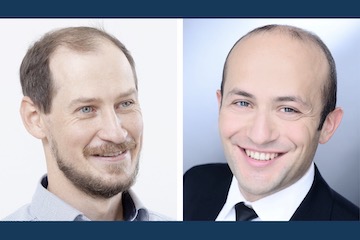Chemists in the Heisenberg Program
High Distinction for two Materials Chain Scientists

© V. Unkovic, © B. Gökce
Developing new materials: Junior Professor Michael Giese does this just like Lecturer Dr. Bilal Gökce - but in very different ways. For their outstanding research, the two chemists from the Materials Chain at University of Duisburg-Essen (UDE) have been accepted into the Heisenberg Program of the German Research Foundation (DFG).
Funding is being provided for Giese's project "Supramolecular liquid crystals - a modular concept for 'smarter' materials", in which he and his team are designing a sort of construction kit. Its components can be assembled to form substances with desired properties.
Liquid crystals are the focus of his research. "We encounter them in everyday life, for example in cell phones or flat screens," explains Giese. "In our module system, we can add structural color components to the liquid crystals. In nature, this color makes bird feathers or insect wings shimmer and is created by the refraction of light.
The exciting thing, says Giese: Depending on the composition of the materials, they react to various changes in the environment. For example, if temperature or light changes, they can modify their properties again and again.
"In the laboratory, we first let nature run wild, it is the master builder, and the molecular building blocks and patterns create themselves autonomously," explains Michael Giese. "The challenge for us is to design the components afterwards so that they can be used in a versatile and flexible way.
Better Materials for 3D Printing
Gökce, on the other hand, focuses on 3D printing. "The enormous potential of powder-based 3D printing has not yet been fully realized because many available materials are still inadequate for these printers. I'm enabling 3D printing of new materials through the targeted addition of nanoparticles and improving the properties of 3D-printed polymer or metal components," the chemist explains.
Bilal Gökce is pursuing two directions. First, he is investigating how laser-based nanoparticle production can be upscaled and the size of the particles produced can be controlled. He uses these nanoparticles to develop new powders for 3D printing of magnets, optics or materials with special mechanical properties. "For the first time, the entire process chain of 3D printing - from material to component - will be explored in a holistic approach," says the UDE scientist.
Gökce himself receives much praise from the DFG reviewers: In his proposal, the DFG states that "the goals and sub-goals are so perfectly described and completely convincingly substantiated that one can be sure that real progress in understanding materials and developing methods will be achieved here."
The Heisenberg Program honors highly qualified researchers in all disciplines and is intended to enable them to work on more advanced topics, among other things. Of the four funding options in the program, the professorship is the most desired.
Further information:
Jun. prof. Dr. Michael R. A. Giese, Organic Chemistry, Supramolecular Materials, Tel. 0201/18-3 2087, michael.giese@uni-due.de
PD Dr. Bilal Gökce, Technical Chemistry I, Tel. 0201/18-3 3146, bilal.goekce@uni-due.de
Editorial Office: Alexandra Nießen, Tel. 0203/37 9-1487, alexandra.niessen@uni-due.de
